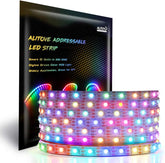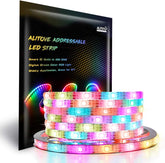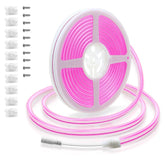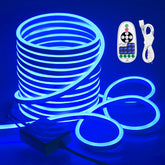LED Controllers: Tips and Tricks for Optimal Lighting Control
Are you an LED lighting enthusiast looking to take your lighting projects to the next level? Look no further! In this comprehensive guide, I’ll walk you through everything you need to know about LED controllers and how to optimize your lighting control. From understanding the basics of LED controllers to exploring the different types and their applications, I’ve got you covered.
Choosing the right LED controller for your project can be daunting, but with my expert tips, you’ll make the perfect choice every time. I’ll also share installation tips to ensure your LED controllers perform at their best, and guide you through programming and customizing them to achieve stunning lighting effects.
Encountering issues? No worries! I’ll help you troubleshoot common problems and enhance your energy efficiency with LED controllers. Plus, stay ahead of the curve with insights into future trends in LED controller technology.
Get ready to unlock the full potential of your LED lights with these tips and tricks for optimal lighting control!
1. Understanding the Basics of LED Controllers
LED controllers are essential devices that manage the operation of LED lighting systems. They allow users to adjust brightness, color, and lighting patterns to create desired effects. Understanding the basics of LED controllers involves knowing how they work, their components, and their role in a lighting setup. This foundational knowledge is crucial for anyone looking to optimize their LED lighting projects.
2. Types of LED Controllers and Their Applications
There are various types of LED controllers, each designed for specific applications. Common types include:
- RGB Controllers: Used for controlling multi-color LED lights, allowing users to mix red, green, and blue to create a wide range of colors.
- DMX Controllers: Often used in professional lighting setups, such as stage lighting, where precise control over multiple lights is required.
- Wi-Fi Controllers: Enable remote control of LED lights via smartphones or other devices, offering convenience and flexibility. Understanding the different types of LED controllers and their applications helps users choose the right controller for their specific needs.
3. How to Choose the Right LED Controller for Your Project
Selecting the right LED controller involves considering several factors:
- Compatibility: Ensure the controller is compatible with your LED lights.
- Functionality: Determine the features you need, such as dimming, color changing, or remote control.
- Ease of Use: Look for user-friendly controllers that are easy to install and operate.
- Budget: Consider your budget and find a controller that offers the best value for your money. By evaluating these factors, you can choose the perfect LED controller for your project.
4. Installation Tips for LED Controllers
Proper installation of LED controllers is crucial for optimal performance. Here are some tips:
- Read the Manual: Always refer to the manufacturer’s instructions for installation guidelines.
- Check Connections: Ensure all connections are secure and correctly wired.
- Test Before Finalizing: Test the controller and lights before finalizing the installation to ensure everything works as expected.
- Use Quality Components: Invest in high-quality components to avoid issues and ensure longevity. Following these tips will help you achieve a successful installation and optimal performance from your LED controllers.
5. Programming and Customizing LED Controllers
Programming LED controllers allows you to create custom lighting effects and patterns. Here are some tips:
- Learn the Basics: Familiarize yourself with the programming interface and basic commands.
- Experiment: Try different settings and effects to see what works best for your project.
- Use Software Tools: Many LED controllers come with software tools that make programming easier.
- Save Presets: Save your favorite settings as presets for quick access in the future. By programming and customizing your LED controllers, you can achieve unique and personalized lighting effects.
6. Troubleshooting Common Issues with LED Controllers
Even the best LED controllers can encounter issues. Here are some common problems and solutions:
- No Power: Check the power supply and connections to ensure the controller is receiving power.
- Flickering Lights: This can be caused by loose connections or incompatible components. Check and secure all connections.
- Unresponsive Controller: Reset the controller and check for firmware updates.
- Color Inconsistencies: Ensure the controller is properly calibrated and compatible with your LED lights. By troubleshooting these common issues, you can keep your LED lighting system running smoothly.
7. Enhancing Energy Efficiency with LED Controllers
LED controllers can help improve energy efficiency in several ways:
- Dimming: Reduce brightness to save energy without compromising on lighting quality.
- Scheduling: Set timers to turn lights on and off automatically, reducing unnecessary usage.
- Adaptive Lighting: Use sensors to adjust lighting based on ambient conditions, optimizing energy consumption. By leveraging these features, you can enhance the energy efficiency of your LED lighting system.
8. Future Trends in LED Controller Technology
The world of LED controllers is constantly evolving. Here are some future trends to watch out for:
- Smart Integration: Integration with smart home systems for seamless control and automation.
- Advanced Customization: More sophisticated programming options for creating complex lighting effects.
- Energy Monitoring: Built-in energy monitoring features to track and optimize energy usage.
- Wireless Technology: Improved wireless connectivity for easier installation and control. Staying informed about these trends will help you stay ahead in the world of LED lighting.
Ready to elevate your LED lighting projects? Discover the best LED controllers and start creating stunning effects today! Click here to explore our top picks.
Conclusion
Mastering the use of LED controllers can significantly enhance your LED lighting projects, providing you with the flexibility and control to create stunning visual effects. By understanding the basics, choosing the right controller, and following best practices for installation and programming, you can optimize your lighting setup for both performance and energy efficiency. Stay ahead of the curve by keeping an eye on emerging trends in LED controller technology. Whether you’re a seasoned enthusiast or just starting out, these tips and tricks will help you unlock the full potential of your LED lights. Ready to take your lighting to the next level? Start exploring the possibilities today!
Quote
-
LED Light Controller: A Comprehensive Guide - This guide covers the importance, versatility, and basic functionality of LED light controllers, including types like WiFi, Bluetooth, and Zigbee controllers. It also discusses integrating LED controllers with smart home systems and future trends in LED light control technology.
-
Understanding LED Controllers and Dimmers - This easy guide explains the core functions of LED controllers, their installation, advantages, and considerations. It also highlights the 0-10V dimming system and its benefits for precise brightness adjustment.





















Leave a comment
Please note, comments need to be approved before they are published.